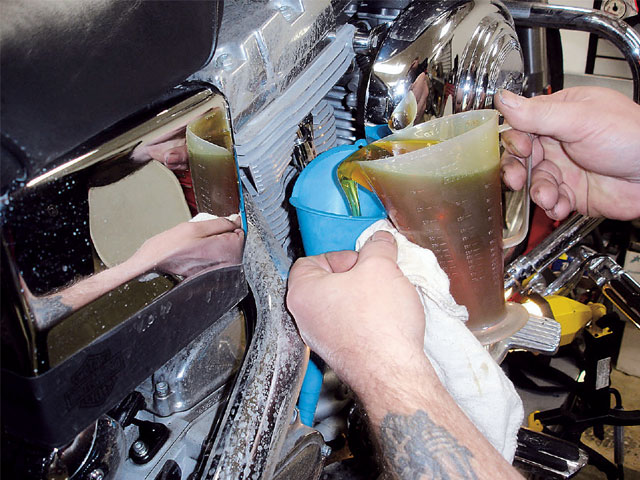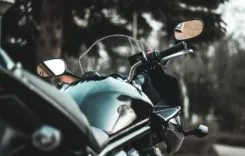Checking Bike’s Essential – Spring Breaks?

Now that it’s springtime and you’re ready to hit the streets again, are you really ready? Just because your battery tender has kept your battery charged up all winter and the fuel stabilizer you poured in your tank shortly after that last ride has kept your gas in good shape, it doesn’t mean you’re really prepared. Most (if not all) of the riders who put their machines away for the winter and bring them out again in the spring should do more than unhook the electrical umbilical cord, dust the baby off, and check the air before they boogie! Sure, we use our machines for recreational purposes as a rule, especially in warmer, dryer weather. But that means it’s most likely been awhile since they had the attention they need to ensure a sweet introduction to another spring season. Even though your hog may have been retired in good working order and garage-pampered all winter, a thorough check of the bike is essential. You should pay particular attention to the following items:
Brakes and Fluid
Brake fluid has a life, and it dies. This is particularly true of late-model Harleys that have switched to “organic” DOT-4 fluids, but even traditional DOT-5 gets contaminated and tired as time goes on. All too often this vital fluid isn’t even checked properly, let alone changed on a frequent basis. Since-more than any other system on your scoot-you bet your butt on good brakes, it only makes sense to maintain them, including the pads. It only takes a minute or two to determine if there’s crud and corrosion on the backing plates or at the hose joints…so do it!
Tire Condition and Pressures
If a machine is not in regular use, the tires deteriorate at an alarming rate. A plain old pressure (check when cold) and tread-depth check is one thing, but “weather checking” for cracks in the sidewalls is another-they can render a tire unsafe and useless. (If you have any doubts in this area, please get second opinions from a dealer or tire supplier.)
Cables
To ensure smooth clutch operation, the best thing you can do is to lube the bejesus out of the cable. Ideally, this should be done when you park the rig in the autumn, but for Pete’s sake be sure to do a thorough job of it when you get ready for this season. The same thing is true-more so, in fact-for throttle cables. These slender cables are the basis for your most intimate contact and fundamental control of your machine. Yet all too often they get crudded up or even rusty after weeks of inactivity. Ten minutes spent lubing and adjusting before your first ride can make light-years’ worth of difference all season!
Fork Seals and Suspension
We hope they’ve never frozen to the fork tube during the worst of winter, but, like tires, they’re perfectly capable of cracking and deteriorating. Leaks are bad for at least two reasons: poor suspension performance, which you can ill afford on roads freshly pot-holed or recently frost-heaved; and potentially slippery surfaces on the bike or the pavement that shouldn’t be. Since rear shocks have seals, too, it makes sense to have a look at them, but mainly you want to check the air shocks if your machine is so equipped. Those narrow hoses have fittings that can shrink, crack, or fail, so it’s best to discover these problems in the garage or driveway rather than out on the road, when it’s too late to do much to fix it.
Belt, Chain, Sprockets, and PulleysYeah, they are tough and pretty impervious to injury these days, but if you don’t check you can’t be sure-and can you honestly remember them being clean as a whistle when you parked for the winter? Mostly what happens with crud and contamination left between the belt and pulley is premature wear, but any undetected bit of shrapnel can cut your ride short. Clean and lube the chain, and check the sprockets and chain for any unusual wear patterns.
Battery
The days of checking specific gravity with a battery tester, then adding distilled water with an eye-dropper, might seem like a scene from the Dark Ages with the advent of tough glass-mat (AGM) batteries. But did you know that 90 percent of “broken down alongside the road” misfortunes still come down to electrical problems? Probably more than 70 percent of those can be attributed to improper (or nonexistent) battery maintenance. These days maintenance is easy-do load tests and make damn sure all the cable connections are surgically clean and tight!
Lights
OK, this one is pretty obvious, but over and above (literally) the headlight, taillight, and turn signals are those little lamps we often call “idiot lights,” as well as the ones that light the gauges at night. You might as well make sure they all work in case you get caught out after curfew. Dressers have additional bulbs to bear in mind, in everything from the saddlebag rails to the fender tips.
Oil-Especially Engine Oil
Spring “cleaning” for an engine, transmission, and primary practically mandates fresh fluids (of the correct type for the task at hand), and-perhaps even more importantly-checking for condensation hiding inside those vital areas. Open the primary inspection covers and wipe the inside of the outer primary with your index finger. Feel anything moist? Even garage-kept scooters occasionally surprise their owners with a little muddy brown mix of oil and water that has accumulated during months of inactivity. If it’s happening in the primary, it pays to check the oil tank/sump and the transmission case as well. Flushing these components and frequently refilling them with fresh lube is easier and better than rebuilding them after corrosives have gotten into bearings and rollers. Another tip is to pay less attention to mileage and more to condition when it comes to oil-change intervals. Short hops are harder on oil than long rides, so check all your vital fluids every second or third fuel fill-up. If your engine’s oil looks dirty or smells bad, or if condensation rears its ugly head in the trans or primary, it’s time to change it, regardless of mileage.
Even if your spring service work is strictly DIY, checks like these are essential. Since two heads are better than one, whether you talk to a dealer or a knowledgeable buddy, it’s good to get a second opinion. Another perspective never hurts when you’re trying to see if you’ve remembered and done everything the scooter needs for the first ride of the season.
Equipment
The motorcycle isn’t all there is to it, after all. Ensure that you thoroughly check your riding gear and safety equipment before putting it to use for the new riding season. Pay particular attention to helmet straps, visors, and face shields. Damage is easy and fairly cheap to fix as a rule, and where face shields are concerned, it’s more important to see well than to look good.
If you have protective clothing (leathers, chaps, gloves, boots, and such), now is the time to clean them and rub ’em down with a good leather treatment. Then wear it all, even if your intended journey is only a short one. You might find that you’re a lot rustier than the sled or your apparel after months out of practice. And accidents and incidents can and do bring a quick end to the beginning of even a short ride.
Luggage and Accessories
Use common sense when loading your machine or fitting additional accessories. When big loads are carried, you should travel at a much lower speed than normal and try to keep as much of the weight as possible between the tires, not hanging off the ends of your scooter. Don’t forget to set tire pressures higher, as recommended by the factory for passenger or load carrying.
Rider
Speaking of payloads-as with any other activity, to be proficient you need to acknowledge that preparation and practice are worth their weight in gold. So consider riding an appropriate “maiden voyage” route on your own, or with one close buddy, avoiding group riding at first.
Don’t take on too long a journey too soon-avoid demanding routes or speeds until you re-familiarize yourself with the controls and handling of your bike. Historically, lots of fatal and serious-injury accidents take place early in the biking calendar. Remember, risk-taking is amplified by poor preparation, whether mental or mechanical. Think of your quality of life and how easily it can be destroyed, not to mention the people around you who need you to come home safely.







